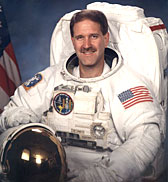 |

|
|
||||
|
John M. Grunsfeld (Ph.D.) NASA BIOGRAPHY Posted: January 7, 2002 PERSONAL DATA: Born in Chicago, Illinois. Married to the former Carol E. Schiff. They have two children. John enjoys mountaineering, flying, sailing, bicycling, and music. His father, Ernest A. Grunsfeld III, resides in Highland Park, Illinois. Carol's parents, David and Ruth Schiff, reside in Highland Park, Illinois. EDUCATION: Graduated from Highland Park High School, Highland Park, Illinois, in 1976; received a bachelor of science degree in physics from the Massachusetts Institute of Technology in 1980; a master of science degree and a doctor of philosophy degree in physics from the University of Chicago in 1984 and 1988, respectively. ORGANIZATIONS: American Astronomical Society. SPECIAL HONORS: WW.D. Grainger Fellow in Experimental Physics, 1988-89. NASA Graduate Student Research Fellow, 1985-87. NASA Space Flight Medals (1995, 1997, 1999). NASA Exceptional Service Medals (1997, 1998). Distinguished Alumni Award, University of Chicago. EXPERIENCE: Dr. Grunsfeld's academic positions include that of Visiting Scientist, University of Tokyo/Institute of Space and Astronautical Science (1980-81); Graduate Research Assistant, University of Chicago (1981-85); NASA Graduate Student Fellow, University of Chicago (1985-87); W.D. Grainger Postdoctoral Fellow in Experimental Physics, University of Chicago (1988-89); and Senior Research Fellow, California Institute of Technology (1989-92). Dr. Grunsfeld's research has covered x-ray and gamma-ray astronomy, high energy cosmic ray studies, and development of new detectors and instrumentation. Dr. Grunsfeld studies binary pulsars and energetic x-ray and gamma-ray sources using the NASA Compton Gamma Ray Observatory, x-ray astronomy satellites, radio telescopes, and optical telescopes. NASA EXPERIENCE: Dr. Grunsfeld was selected by NASA in March 1992, and reported to the Johnson Space Center in August 1992. He completed one year of training and is qualified for flight selection as a mission specialist. Dr. Grunsfeld was initially detailed to the Astronaut Office Mission Development Branch. Following his first flight, he led a team of engineers and computer programmers tasked with defining and producing the crew displays for command and control of the International Space Station (ISS). As part of this activity he directed an effort combining the resources of the Mission Control Center (MCC) Display Team and the Space Station Training Facility. The result was the creation of the Common Display Development Facility (CDDF), responsible for the onboard and MCC displays for the ISS, using object-oriented programming techniques. Following his second flight he was assigned as Chief of the Computer Support Branch in the Astronaut Office supporting Space Shuttle and International Space Station Programs and advanced technology development. A veteran of three space flights, STS-67 in 1995, STS-81 in 1997, and STS-103 in 1999, Grunsfeld has logged over 835 hours in space, including two space walks totaling 16 hours and 23 minutes. Following STS-103 Grunsfeld was named Chief of the Extravehicular Activity Branch in the Astronaut Office. He is currently assigned as the Payload Commander on the STS-109 mission, to upgrade and service the Hubble Space Telescope during 5 space walks, scheduled for launch early in 2002. SPACE FLIGHT EXPERIENCE: STS-67 Astro-2 (March 2-18,1995) was the second flight of the Astro observatory, a unique complement of three telescopes. During this record-setting 16-day mission, the crew conducted observations around the clock to study the far ultraviolet spectra of faint astronomical objects and the polarization of ultraviolet light coming from hot stars and distant galaxies. Mission duration was 399 hours and 9 minutes. STS-81 (January 12-22, 1997) was a ten-day mission, the fifth to dock with Russia's Space Station Mir, and the second to exchange U.S. astronauts. The mission also carried the Spacehab double module providing additional middeck locker space for secondary experiments. In five days of docked operations more than three tons of food, water, experiment equipment and samples were moved back and forth between the two spacecraft. Following 160 orbits of the Earth the STS-81 mission concluded with a landing on Kennedy Space Center's Runway 33 ending a 3.9 million mile journey. Mission duration was 244 hours, 56 minutes. STS-103 (December 19-27, 1999) was an 8-day mission during which the crew successfully installed new instruments and upgraded systems on the Hubble Space Telescope (HST). Enhancing HST scientific capabilities required three space walks (EVA). Grunsfeld performed two space walks totaling 16 hours and 23 minutes. The STS-103 mission was accomplished in 120 Earth orbits, traveling 3.2 million miles in 191 hours and 11 minutes.
|

|